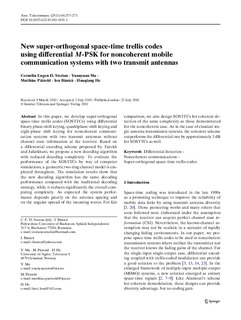New super-orthogonal space-time trellis codes using differential M-PSK for noncoherent mobile communication systems with two transmit antennas
Journal article, Peer reviewed
Permanent lenke
http://hdl.handle.net/11250/137911Utgivelsesdato
2011Metadata
Vis full innførselOriginalversjon
Sterian, C. E. D., Ma, Y., Pätzold, M., Banica, I., & He, H. (2011). New super-orthogonal space-time trellis codes using differential M-PSK for noncoherent mobile communication systems with two transmit antennas. Annals of Telecommunications-Annales Des Telecommunications, 66(3-4), 257-273. doi: 10.1007/s12243-010-0191-1Sammendrag
In this paper, we develop super-orthogonal space-time trellis codes (SOSTTCs) using differential binary phase-shift keying, quadriphase-shift keying and eight-phase shift keying for noncoherent communication systems with two transmit antennas without channel state information at the receiver. Based on a differential encoding scheme proposed by Tarokh and Jafarkhani, we propose a new decoding algorithm with reduced decoding complexity. To evaluate the performance of the SOSTTCs by way of computer simulations, a geometric two-ring channel model is employed throughout. The simulation results show that the new decoding algorithm has the same decoding performance compared with the traditional decoding strategy, while it reduces significantly the overall computing complexity. As expected the system performance depends greatly on the antenna spacing and on the angular spread of the incoming waves. For fair comparison, we also design SOSTTCs for coherent detection of the same complexity as those demonstrated for the noncoherent case. As in the case of classical single antenna transmission systems, the coherent scheme outperforms the differential one by approximately 3 dB for SOSTTCs as well.
Beskrivelse
Published version of an article in the journal: Annals of Telecommunications-Annales Des Telecommunications. Also available from the publisher at: http://dx.doi.org/10.1007/s12243-010-0191-1
